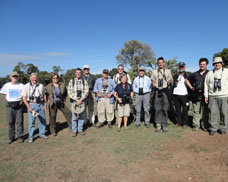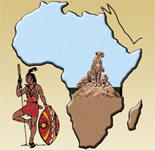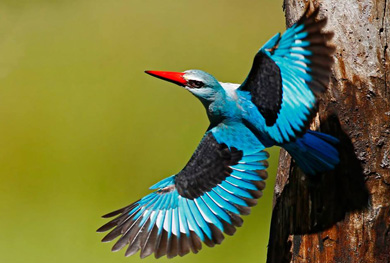October Kenya Birding Safari & Wildlife Tour
fromDuration: 17 Days Kenya Birding Tour
Tour Date 2nd – 16th Oct 2023 – 2024
Accommodation Options:
Castle forest Lodge
Samburu Lodge
Lake Nakuru Sarova
Lake Baringo Soi Lodge
October Birding safari holidays in Kenya and Everything to know about Bird watching safari holidays in Kenya also everything to know accommodation, lodges, Birding safari camps on Africa tours, Kenya safaris, wildlife birdwatching photography tour.
-
Reviews 0 Reviews0/5
-
Vacation Style Holiday Type
-
Activity Level
-
Bird watching Kenya tours, wildlife Photography Safari.

Day 1
Departure from Europe destination for overnight flight to Nairobi (flight ticket not Included in Our price).
Day 2: 2nd Oct 2023 – 2024
Morning arrival in Nairobi and transfer to Mountain Lodge, with several short stops en route. Our first destination is the Blue Post Hotel in Thika, where we will bird the hotel grounds and woodlands along the Chania River. Here we will start seeing our first exciting African species, which may include Hadada Ibis, Red-eyed Dove, African Green-pigeon, Speckled Mouse-bird, Cinnamon-chested Bee-eater, Silvery-cheeked Hornbill, White-headed and Spot-flanked Barbets, Yellow-rumped Tinkerbird, Mountain Wagtail, Grey-olive Greenbul, Black-throated Wattle-eye, Grey-capped Warbler, Variable, Collared and Scarlet-Chested Sunbirds, Holub’s Golden-weaver, Baglafecht Weaver and African Citril. Our second stop will be at the large Tana River, where we should find Moustached Grass-warbler, African Golden-weaver, Yellow Bishop, and Brown-backed and Bronze Mannikins. We will also make a stop at Wajee Camp, a noted site for the endemic Hinde’s babbler. While birding the steep forested slopes of the camp, we stand a chance of locating Ayre’s Hawk-eagle, African Wood-owl, Brown-hooded Kingfisher, and Green-headed Sunbird. Mountain Lodge is located on the lower slopes of Mt. Kenya, Africa’s second tallest mountain, and is an excellent place to locate many highland forest species. Along the entrance road we may encounter Augur Buzzard, Crowned Hawk-eagle, Hartlaub’s Turaco, Moustached Tinkerbird, Mosque Swallow, Black Saw-wing, Sharpe’s Starling, Black-tailed Oriole, Purple-throated Cuckoo-shrike, African Paradise-flycatcher, Cape Robin-Chat, African Stonechat, Broad-ringed White-eye, and Eastern Double-collared Sunbird. The large waterhole and salt lick at the lodge is host to many mammals and we can expect Blue Sykes Monkey, White-tailed and Marsh Mongooses, Common Genet, Bushbuck, Giant Forest Hog, and the tiny Suni. At an elevation of almost 8,000ft nights can be quite chilly. One night stay at the Forest Mountain Lodge.
Days 3-4: 3rd & 4th Oct 2023 – 2024
Early-morning birding from the lodge grounds is always productive and may include Marabou Stork, Black Goshawk, Delegourge’s (Eastern Bronze Naped) Pigeon, Fine-banded Woodpecker, Cape Wagtail, Slender-billed and Mountain Greenbuls, Rüppell’s Robin-chat, Hunter’s Cisticola, Grey and Black-throated Apalis, Grey-headed Negrofinch and Yellow-crowned Canary. We will also take a short walk from the lodge along the entrance road in search of the more secretive species of the area such as Scaly Francolin, African Hill Babbler, White-starred Robin, Chestnut-throated Apalis, Mountain Yellow Warbler, White-browed Crombec, Yellow-bellied Waxbill and Oriole Finch. Mid-morning we will leave the cool climate of Mt Kenya for more arid country in the north, specifically the Samburu Game Reserve. The drive will offer spectacular scenery, and the grasslands along the roadside are a great place for Black-winged Plover, Black-shouldered Kite, Dusky Turtle-dove, Angola Swallow, Greater Blue-eared Glossy-starling, Cape Rook, Boran Cisticola, Tacazze Sunbird, Red-collared and Long-tailed Widowbirds (seasonal) and Speke’s Weaver. Samburu is one of the most exciting reserves in East Africa. The semi-desert habitat and the rich woodlands along the Ewaso Nyiro River are teeming with wildlife. Exploration of the fantastic reserve will produce an almost overwhelming array of bird species: Palm-nut and Hooded Vultures, Bateleur, Martial Eagle, African Hawk-eagle, Crested and Yellow-necked Francolins, Vulturine Guineafowl, Buff-crested and White-bellied Bustards, Black-faced and Lichtenstein’s Sandgrouse, Red-bellied Parrot, African Scops-Owl, Pearl-spotted Owlet, Somali Bee-eater, Rufous-crowned Roller, Von der Decken’s Hornbill, Red-and-yellow Barbet, Bearded Woodpecker, Pink-breasted Lark, African Bare-eyed Thrush, Rosy-patched Bush-shrike, Hunter’s and Black-bellied Sunbirds, Golden-breasted and Fischer’s Starlings, Donaldson-Smith’s Sparrow-weaver, Cut-throat and the stunning Somali Bunting. Mammal life is also prolific, with many species not seen elsewhere on our tour. Just a few of the many possibilities are Olive Baboon, Black-faced Vervet Monkey, Dwarf Mongoose, Striped Hyena, Grevy’s Zebra, Reticulated Giraffe, Kirk’s Dikdik, Common Waterbuck, Gerenuk and the magnificent Beisa Oryx. Two nights stay at the Samburu Lodge.
Day 5: 5th Oct 2023 – 2024
On our last morning in Samburu we will visit the nearby Buffalo Springs Game Reserve. The slightly different habitat is home to many specialities: Somali Ostrich, Lappet-faced Vulture, Rüppell’s Griffon- vulture, Eastern Chanting-goshawk, Pygmy Falcon, Cream-coloured (Somali) Courser, Chestnut-bellied Sandgrouse, White-headed Mouse-bird, Eastern Yellow-billed Hornbill, Nubian and Cardinal Woodpeckers, Fischer’s and Chestnut-headed Sparrow-larks, Yellow-vented Eremomela, Spotted Morning-thrush, Marico Sunbird, Taita Fiscal, Golden Palm Weaver, Black-capped Social Weaver and African Silverbill. We then have a mid-morning departure for the Naro Moro River Lodge located on the northern edge of Mt Kenya. En route we will make a stop at the Meru Forest, where many unique species can be found. Much of the bird life here resembles the coastal avifauna of Kenya. Here we will search for White-eared Barbet, Yellow-bellied Greenbul, Black-headed Apalis, African Crested-flycatcher and Kenrick’s and Black-bellied Glossy-starlings. Our lodge is set in the perfect setting of highland forest, flowing brooks, and gorgeous flower filled grounds. The birding in this area is also very nice and we may see African Black Duck, Narina Trogon, Sulphur-breasted Bush-shrike, Tropical Boubou, Chin-spot Batis, African Black-headed Oriole, and Red-cheeked Cordon-bleu. One night stay at the Naro Moro River Lodge. Scarlet-chested Sunbird, Silvery-cheeked and Trumpeter Hornbills and Brown-hooded Kingfisher can all be seen here.
Day 6, 6th Oct 2023 – 2024
Leaving early we will make an ascent onto Mt Kenya entering the vast and pristine montane forest of Mt Kenya National Park. We will be leaving mid-day and transferring to Lake Nakuru National Park allowing time to search for several key species along the way. A large rocky escarpment en-route is a favourite roosting spot for the Mackinder’s Eagle-Owl and with some luck we should be able to locate this highly sought-after species. The Acacia scrub by a nearby lake is a favourite haunt for Little Grebe, Yellow-billed Duck, Red-winged Starling, Little Rock-thrush, Pale Flycatcher, and Purple Grenadier. In the afternoon we will arrive at Lake Nakuru National Park, which is called by some, the greatest birding spectacle on earth! Huge numbers of Lesser Flamingos feed in the shallow alkaline water, sometimes up to a million, with smaller numbers of Greater Flamingos. Exploring the Acacia woodland and the lakeside marshes we will no doubt encounter many wonderful avian delights: Great White Pelican, Great Cormorant, African Spoonbill, African Fish-eagle, African Harrier-hawk, Hildebrandt’s Francolin, Grey-headed Gull, Broad-billed Roller, Levaillant’s Cuckoo, White-browed Coucal, Green Wood-hoopoe, Rufous-necked Wryneck, Grey Woodpecker, Black Cuckoo-shrike, Northern Anteater-chat, Grey-backed Fiscal, Brown-crowned Tchagra and African Firefinch. Mammals are also quite common in the park and it is one of the few places in East Africa where the endangered White Rhino can be found. Some of the other mammals we hope to find include Rothchild’s Giraffe and Reedbuck. One night stay at the Lake Nakuru Lodge.
Days 7-8: 7th & 8th Oct 2023 – 2024
All morning will be spent in Lake Nakuru National Park. More bird possibilities include Hamerkop, Cape and Hottentot Teals, Tawny Eagle, Kittlitz’s Plover, Red-chested and Klaas’ Cuckoos, Nyanza Swift, Greater Honeyguide, White-browed Robin-chat, Arrow-marked Babbler, Grey-crested Helmet-shrike, Rüppell’s Glossy-starling, and Golden-breasted Bunting. Our next destination is a fresh-water lake in the north called Lake Baringo. Here the combination of a large lake in semi-desert country and the nearby Baringo cliffs provide the perfect habitat for a great diversity of bird life. Specialties in this area are Dark Chanting-goshawk, Heuglin’s Courser, Northern White-faced Owl, Greyish Eagle-owl, Slender-tailed Nightjar, Jackson’s and Hemprich’s Hornbills, Black-throated Barbet, Red-fronted Warbler, Brown-tailed Chat, Somali Tit, Beautiful Sunbird, Bristle-crowned Starling, Golden-backed and Little Weavers, Northern Masked-weaver and Northern Red Bishop. Other possibilities in the area include Lanner Falcon, Verreaux’s Eagle, Blue-naped Mousebird, Madagascar Bee-eater, Red-fronted Barbet, Northern Crombec, Pygmy Batis, Cardinal Quelea and Eastern Paradise-whydah. Two nights stay at the Lake Baringo Soi Lodge.
Days 9-11: 9th-11th Oct 2023 – 2024
After some final birding around the Lake Baringo area we will depart for the Kakamega Rainforest in the western highlands, en route stopping for special interest birds in the Kerio Valley. These may include Black-headed Lapwing, Meyer’s Parrot, White-crested Turaco, African Black and Horus Swifts, African Pygmy-kingfisher, Double-toothed Barbet, Long-billed Pipit, Silverbird, Brown Babbler, White-crested Helmet-shrike, Black-headed Gonolek, Chestnut-crowned Sparrow-weaver and Reichard’s Seedeater. Kakamega Rainforest is the eastern most extension of the Congo Rainforest and is without doubt the best birding destination in the entire country. Many of the species here are found nowhere else in Kenya and the list of possibilities is seemingly endless. Such avian gems as White-spotted Flufftail, Great Blue Turaco, Bar-tailed Trogon, Blue-headed Bee-eater, Black-and-white-casqued Hornbill, Grey-throated, Yellow-spotted and Yellow-billed Barbets, Golden-crowned and Brown-eared Woodpeckers, African Broadbill, 13 species of greenbul, Brown-chested Alethe, Banded and White-chinned Prinias, Black-faced Rufous-warbler, Equatorial Akalat, Snowy-crowned Robin-chat, African Shrike-flycatcher, Chestnut, Jameson’s, Brown-throated and Yellow-bellied Wattle-eyes, African Blue Flycatcher, Dusky Tit, Green-throated, Green and Northern Double-collared Sunbirds, Western Black-headed Oriole, Mackinnon’s Fiscal, Pink-footed Puffback, Grey-green and Luehder’s Bush-shrikes, Stuhlmann’s Starling, Black-billed and Vieillot’s Weavers, Red-headed Malimbe, Red-headed Bluebill, and Black-and-white Mannikin. Rainforest mammals to be expected are: Eastern Black-and-white Colubus, Gentle and Red-tailed Monkeys and the very active Red-legged Sun-squirrel. Three nights stay at Rondo Retreat Centre.
Days 12-13: 12th & 13th Oct 2023 – 2024
Early morning we will depart for Kisumu on the northeastern shore of Lake Victoria where we will search for the specialties of the area, some of which are found only in the papyrus swamps surrounding this great lake. Species we are likely to see are African Openbill, Abdim’s Stork, Water Thick-knee, Long-toed Lapwing, Eastern Grey Plantain-eater, Blue-headed Coucal, Black-billed Barbet, Yellow-fronted Tinkerbird, Greater Swamp-warbler, Swamp Flycatcher, Birds to be Red-chested and Copper Sunbirds, Papyrus Gonolek, Slender-billed, Black-headed and Northern Brown-throated Weavers, Black-winged Bishop, Fan-tailed Widowbird and Papyrus Canary. From Lake Victoria we will proceed to the Masai Mara Game Reserve in South-Western Kenya. The Mara is the northern extension of the famous Serengeti plains. Here we will find a wide assortment of bird life, as well as some of the most spectacular mammals on the continent. Complimenting the wildlife is the dramatic scenery of endless grasslands, lush river valleys, and steep rock strewn escarpments. Birds we can expect in this area of the Mara are Rufous-bellied Heron, Saddle-billed Stork, Wahlberg’s Eagle, Coqui and Red-necked Francolins, Grey Crowned-crane, Temminck’s Courser, Wattled Lapwing, Ross’ and Schalow’s Turaco, Malachite and Woodland Kingfishers, Yellow-throated Longclaw, Rufous-chested Swallow, White-tailed Lark, Familiar Chat, Silverbird, Red-faced, Trilling and Tabora Cisticolas, Green-capped Eremomela, Black-crowned Tchagra, Hildebrandt’s and Violet-backed Starlings, Yellow-fronted Canary and Cinnamon-breasted Bunting. This is the best area in the Mara to see big game up close and some of the many mammals to be seen here include Black-backed Jackal, Bat-eared Fox, Banded Mongoose, Spotted Hyena, Serval Cat, African Lion, Leopard, Cheetah, Bush Hyrax, African Elephant, Common Zebra, Hippopotamus, Common Warthog, Masai Giraffe, African Buffalo, Eland, Steinbuck, Bohor Reedbuck, Thomson’s and Grant’s Gazelles, Impala, Topi, Coke’s Hartebeest, and thousands of Wildebeest. We will also see many massive Nile Crocodiles, some over 15ft in length, basking in the sun along the banks of the Mara River. Two nights stay at the Mara Serena Lodge or Mara west camp
Day 14, 14th Oct 2023 – 2024
Leaving early we will travel across the Mara, en route crossing the famous Mara River. We will make a stop at the well-named Hippo Pools to see these huge beasts at close range. While birding the bush-covered hills and open grasslands we should find Secretary-bird, White-headed Vulture, Black-breasted and Brown Snake-eagles, Grey Kestrel, Southern Ground-hornbill, Little Bee-eater, Rosy-breasted Longclaw, Rufous-naped and Flappet Larks, Sooty Chat, Red-billed and Yellow-billed Oxpeckers, Cardinal Quelea, Yellow-shouldered Widowbird, Grey-capped Social-weaver and African Quail-finch. One night stay at the Mara Sarova Tented Camp.
Day 15, 15th Oct 2023 – 2024
Leaving early we will bird the Acacia woodland in the Siana Springs area of the southern Mara. This area is home to several species seen nowhere else in the country. Some of the specialties may include Bare-faced Go-away-bird, Magpie Shrike, Miombo Camaroptera, African Penduline-tit, Croaking Cisticola, Red-throated Tit, Red-headed Weaver, Black-throated Canary and Golden-breasted Bunting. Mid-morning we will depart for Lake Naivasha traveling through the Great Rift Valley. While en route we may come across Egyptian Vulture, Greater Kestrel, Kori Bustard, Grey-rumped Swallow, Schalow’s and Capped Wheatears and Red-billed Quelea. An afternoon arrival will allow us to bird the tall Acacia woodland on the beautiful hotel grounds. expected here are Gabar Goshawk, Dideric and Black Cuckoos, Barn Owl, Verreaux’s Eagle-owl, White-fronted Bee-eater, Lesser and Wahlberg’s Honeyguide, Black-lored Babbler, Amethyst Sunbird, Grey-headed Bush-shrike and Spectacled Weaver. One night stay at the Lake Naivasha Country Club.
Day 16,16th Oct 2023 – 2024
We will spend our last day in Kenya birding with an exciting morning boat trip on Lake Naivasha. Specialty birds we will be looking for while out on the lake include Pink-backed Pelican, Goliath and Purple Herons, Southern Pochard, African Marsh-harrier, Purple Swamphen, Lesser Moorhen, Three-banded Plover and Lesser Swamp-warbler. Mid-morning we will depart for Nairobi, making several birding stops en route. Our first destination is the Kinangop Plateau where we hope to find the endemic Sharpe’s Pipit. This species has been on the decline in the last few years, mainly due to habitat loss, but with some luck we’ll be able to locate this very special bird. Next will be the Gatamaiyu Forest on the Kikuyu Escarpment, an area of middle-elevation forest, which is home to several species not yet seen on the tour. The main target birds in this area are Cameroon Scrub-warbler, White-tailed Crested-flycatcher, Placid Greenbul, Black-fronted Bush-shrike and the nomadic Abbott’s Starling. Our final birding stop is at the Limuru Pond located just off the main highway. A large ridge overlooks the pond and from this vantage point we should be able to locate Madagascar Pond-heron, Intermediate Egret, White-backed and Maccoa Ducks, White-faced and Fulvous Whistling-ducks, Black Crake and Whiskered Tern. In the late afternoon we drive back to Nairobi and transfer you to the Airport to connect your flight back home with evening flight.
USD$5,780 per person sharing room
A Single Room Supplement of US$1,200.
General Information: The climate is generally warm and hot during the day but cold and chilly at some places in the evenings. Accommodation standards are good with en-suite in all rooms. Food is of European standard. Transport is by minibus or four-wheel drive and the road conditions are reasonable. There are special health requirements. Visas are required and cost either £35 in advance or $50 in Kenya. Only a moderate degree of fitness is needed. Photographic opportunities are excellent.
Group size: Minimum number for tour to go ahead: 6 maximum group size:
Prices include to Nairobi, all transport in Kenya by 4×4 Vehicles with pop-up roof, accommodation in twin-bedded rooms with private facilities, all meals and all guiding services.
Excluded are insurance, alcoholic drinks, International return ticket, Tips/Gratitude to the driver/Guide and items of a purely personal nature.
Tips Guideline is USD$10-20 per person per day to the driver and the guide, On hotels and lodges waiters and porters is USD$1-5

